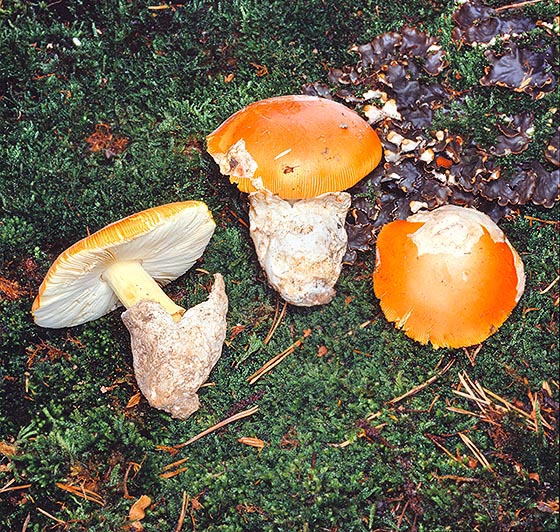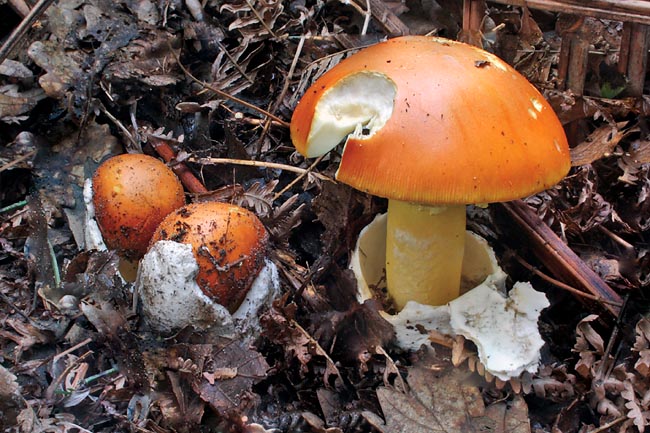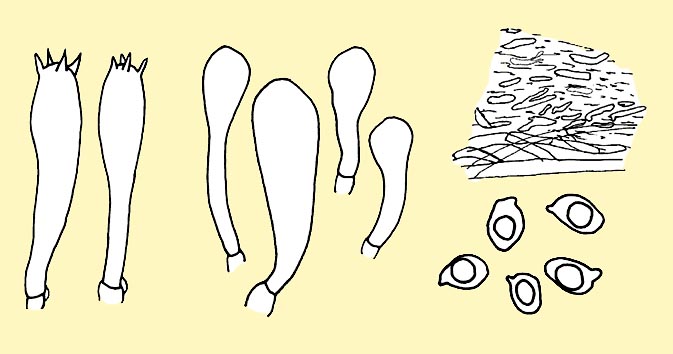
Text © Pierluigi Angeli

English translation by Mario Beltramini

Amanita caesarea is a choice edible in the Mediterranean area © Giuseppe Mazza
Family: Amanitaceae R. Heim ex Pouzar, 1983
Genus: Amanita Persoon, 1794
Subgenus: Amanita Singer, 1962
Section: Amanitopsis (Roze) Konrad & Moublanc, emendamento Neville & Paoumarat, 2004
Subsection: Caesareae (Singer) Drehmel, Vilgalys & Moncalvo, 1999.
Amanita caesarea (Scopoli : Fries) Persoon, 1801
The name of the species, caesarea, comes from the Latin “Cæsáreus” = of Caesar, Roman emperor; of the Caesars.
This species is very much known in the southern European thermophilous zones: Austria, Italy, France, Spain, and Morocco. As a consequence also the local or common names are many: “ovulo”, “ovulo buono”, “cocco”, “boleto” in Italy; “oronja”, “amanita de los Césares”, “yema de huevo”, “ou de reig”, “kuleto”, “gorringo” in Spain; “oronge”, “amanite des César” “oronge vraie” in France; “Kaiserpilz”, “Orangegelber Wulstling” in Germany; “Caesar’s Mushroom” in England.
Description of the subgenus, Subsection and Section
To the Subgenus Amanita are ascribed those fungi which have, apart some rare exception, an evident furrow at the margin of the cap, truncated lamellulae and non-amyloid spores. To the Section Amanitopsis are ascribed those fungi with non-amyloid spores, from globulous to ellipsoidal, always furrowed margin, base of the stem not bulbous, universal veil which may be membranaceous or sub-membranaceous, partial veil forming a membranaceous ring (Subsection Caesareae) or wholly adherent to the stem (Subsection Vaginatinae). To the Subsection Caesareae belong those fungi having not bulbous base of the stem, margin of the cap always striated or furrowed, membranaceous universal veil forming a saclike volva at the base of the stem, membranaceous ring always present, more or less elongated, non-amyloid spores.
Description of the species
Cap: 5-18 cm, initially hemispheric, then convex, finally flat when ripe, without umbo; margin, obtuse, regular, clearly striated or furrowed; surface glossy, smooth, glabrous, somewhat viscous, easily removable, at times it may have some white loose white scales (remnant of the universal veil); colour bright orange-red, uniform, with the dry weather it may decolour to more or less dark orange-yellow.
Hymenium: free gills, dense, wide, thick, intercalated by few truncated lamellulae; of yellow colour, sulphur-yellow when old; entire thread, concolorous.

Egg-like when coming out under latifoliates in warm and dry soils © Maria Tullii
Stem: 8-15 x 2-3 cm, cylindroid, slender, often short, and at times attenuated on the top, with enlarged base but not bulbous, taproot-like, full then filled; more or less smooth surface, of the same colour as the gills.
Ring: membranaceous, wide, pendulous, persistent, striated on the upper face, yellow.
Volva: wide, membranous, firm, sac-like, with margin not attached to the stem, lobed; white, pale beige when ripe.
Flesh: firm, compact, soft, finally flabby when ripe, fibrous in the stem, white in the inner part, yellowish in the outer one; pleasant light smell, unpleasant when old, mild taste, good.
Habitat: it is a thermophilic species, of the Mediterranean zones with siliceous-calcareous soils, it mainly grows in late summer under latifoliate trees (preferably, chestnut and oak), in warm and dry locations.
Edibility: choice edible, much sought for, commercialized, it is by sure one of the few fungi which may be consumed raw, known since the old times, by Greeks as well as by Romans.
Reactions: phenol on the flesh of the stem: before pink, then dark violet or brownish.
Microscopy: white spores, ovoidal, ellipsoidal, smooth, non-amyloid, 9-12 × 6-7,5 µm. Clavate basidia, with joint buckles, tetrasporic, rarely with 1-2 sterigmata, 53,2 – 70 × 11,2 – 12,6 µm. Clavate cystidia, with rounded tip, 28-45 × 10-15 µm. Cuticle formed by lying filamentous hiphae, 2-5 µm broad, gelled. The volva is formed, in the outer part, by sectate filamentous hiphae, with joint buckles, in the inner one are present some spherocysts.
Remarks: it is a much sought for fungus and much appreciated since the old times; by the ancient Romans it was considered as the food of the gods, reserved for the Caesars (from which, the name “caesarea”). Fairly common in the Mediterranean zones, on Italy is also amply commercialized and comes to the Italian markets in particular from the Iberian Peninsula.

Basidi, cystidia, cuticle and spores of Amanita caesarea © Pierluigi Angeli
It is one of the few fungi species which may be consumed raw, as there is no knowledge of cases of intoxication due to the ingestion of this mushroom, either raw or cooked. It goes without saying that only young specimens and in perfect status of conservation must be selected. On the other hand, the old and badly conserved specimens emit an unpleasant smell starting from the volva.
Morphologically, it is unmistakable, if all its peculiar characters are present at the same time, i.e.: the more or less strong orange cap; the uniform egg yellow colour of the gills, of the ring and of the stem, the typical striation at the margin of the cap, the colour of the flesh, yellow in the outer part, whitish inside, the membranous volva, saclike, white. However, in very rainy periods, the Amanita muscaria (L. ex Fr.) Hooker, which has more or less red cap, and white gills, sac and ring, may get more or less similar hues, due to the washout of the cuticle pigments, but it will never have the robust and membranous volva typical of A. caesarea as that of A. muscaria is dissociated in scales or warts, practically inexistent in very rain weather.
The Russula aurea Persoon, due to the colourof the cap and of the gills may be mistaken with the Amanita caesarea, but has no volva and ring.
Synonyms: Agaricus caesareus Scopoli 1772 (basionym); Agaricus aureus Batsch 1783; Agaricus aurantius Bulliard 1812; Amanita aurantiaca Persoon 1801; Fungus caesareus (Scopoli) Kuntze 1898; Venenarius caesareus (Scopoli) Murrill 1913; Volvoamanita caesarea (Scopoli) E. Horak 1968.
→ For general notions about Fungi please click here.
→ To appreciate the biodiversity of MUSHROOMS please click here.
